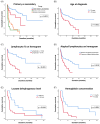Distribution and clinical features of lymphomas involving skin in Taiwan
- PMID: 36794661
- PMCID: PMC11895942
- DOI: 10.1002/kjm2.12659
Distribution and clinical features of lymphomas involving skin in Taiwan
Abstract
A wide variety of primary and secondary lymphoma types involves the skin. However, reports with comparisons between both groups are limited in Taiwan. We retrospectively enrolled all cutaneous lymphomas and evaluated their clinicopathologic features. There were 221 cases of lymphoma: 182 (82.3%) primary and 39 (17.7%) secondary. Mycosis fungoides was the most common primary T-cell lymphoma, 92 (41.7%) cases, followed by CD30-positive T-cell lymphoproliferative disorders including lymphomatoid papulosis (n = 33, 14.9%) and cutaneous anaplastic large cell lymphoma (n = 12, 5.4%). The most frequent primary B-cell lymphomas were marginal zone lymphoma (n = 8, 3.6%) and diffuse large B-cell lymphoma (DLBCL), leg type (n = 8, 3.6%). DLBCL including variants was the most common secondary lymphoma involving skin. Most primary lymphomas presented at low-stage (T-cell, 86%; B-cell, 75%), whereas the majority of secondary lymphomas presented at high-stage (T-cell, 94%; B-cell, 100%). Patients with secondary lymphomas had an older mean age, more frequent B symptoms, lower serum albumin and hemoglobin, and a higher frequency of atypical lymphocytes in blood than those with primary lymphomas. In primary lymphomas, older age, lymphoma types, decreased lymphocyte counts and atypical lymphocytes in blood were poorer prognostic factors. In secondary lymphoma patients, lymphoma types, high serum lactate dehydrogenase and low hemoglobin levels predicted poorer survival. We found that the distribution of primary cutaneous lymphomas in Taiwan mirrors that of other Asian countries but shows some differences as compared with Western countries. Primary cutaneous lymphomas have a better prognosis than secondary lymphomas. Histologic classification of lymphomas highly correlated with disease presentation and prognosis.
Keywords: clinicopathologic factors; cutaneous lymphoma; primary; prognosis; secondary.
© 2023 The Authors. The Kaohsiung Journal of Medical Sciences published by John Wiley & Sons Australia, Ltd on behalf of Kaohsiung Medical University.
Conflict of interest statement
All authors declare no conflict of interest.
Figures

Similar articles
-
The spectrum of cutaneous lymphomas in patients less than 20 years of age.Pediatr Dermatol. 2004 Sep-Oct;21(5):525-33. doi: 10.1111/j.0736-8046.2004.21500.x. Pediatr Dermatol. 2004. PMID: 15461755
-
Clinicopathologic analysis of cutaneous lymphoma in taiwan: a high frequency of extranodal natural killer/t-cell lymphoma, nasal type, with an extremely poor prognosis.Arch Pathol Lab Med. 2010 Jul;134(7):996-1002. doi: 10.5858/2009-0132-OA.1. Arch Pathol Lab Med. 2010. PMID: 20586627
-
Central Nervous System Manifestations of Cutaneous Lymphomas.Curr Neurol Neurosci Rep. 2025 Mar 25;25(1):27. doi: 10.1007/s11910-025-01416-8. Curr Neurol Neurosci Rep. 2025. PMID: 40131611 Review.
-
Incidence and ten-year follow-up of primary cutaneous lymphomas: a single-centre cohort study.Eur J Dermatol. 2018 Feb 1;28(1):44-49. doi: 10.1684/ejd.2017.3183. Eur J Dermatol. 2018. PMID: 29171395
-
[Prognosis of primary cutaneous lymphomas].Ann Dermatol Venereol. 2002 Jan;129(1 Pt 1):30-40. Ann Dermatol Venereol. 2002. PMID: 11937927 Review. French.
References
-
- Kim YM, Jeong SH, Kim JW, Lee SH, Hwang JH, Park YS, et al. Chronic hepatitis B, non‐Hodgkin's lymphoma, and effect of prophylactic antiviral therapy. J Clin Virol. 2011;51(4):241–5. - PubMed
-
- Yasukawa K, Kato N, Kodama K, Hamasaka A, Hata H. The spectrum of cutaneous lymphomas in Japan: a study of 62 cases based on the World Health Organization classification. J Cutan Pathol. 2006;33(7):487–91. - PubMed
-
- Assaf C, Gellrich S, Steinhoff M, Nashan D, Weisse F, Dippel E, et al. Cutaneous lymphomas in Germany: an analysis of the central cutaneous lymphoma registry of the German Society of Dermatology (DDG). J Dtsch Dermatol Ges. 2007;5(8):662–8. - PubMed
MeSH terms
Grants and funding
LinkOut - more resources
Full Text Sources
Medical

